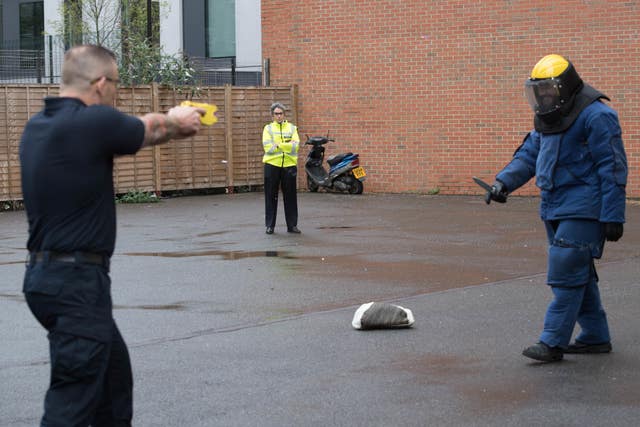Police risk “losing the trust and confidence of the communities they serve” if they do not address serious concerns over the use of Tasers, the policing watchdog has warned.
Analysis by the Independent Office for Police Conduct (IOPC) raised concerns about the increased use of Tasers on children and the mentally ill, and said there were several examples of “missed opportunities” for police to de-escalate the situation before drawing the weapon, which works by sending electric pulses through the body, causing temporary incapacitation.
The IOPC also found that black people were more likely to be subjected to prolonged Taser discharge, compared with white people, according to a review of 101 investigations the watchdog carried out involving Tasers between 2015 and 2020.

But police groups said the report was based on so few incidents as to be “insignificant”, considering Home Office data found there were 32,000 Taser incidents in 2019-20 alone, and described the findings as “vague”.
The report – which also highlights examples of good practice – makes a slew of recommendations, including improvements to training, guidance and monitoring of Taser use.
Michael Lockwood, IOPC director general, said: “We recognise that Tasers are an important tool in policing.
“However, if the concerns identified in our report are not addressed, there is a risk the police will lose the trust and confidence of the communities they serve.”

He added: “Ultimately, policing has to change and be more responsive to community concern or risk losing legitimacy in the eyes of the public.”
The report comes against a backdrop of concern over the disproportionate use of Tasers in cases involving black people.
The device also featured prominently in the recent court case of police officer Benjamin Monk, who was convicted of manslaughter when he kicked to death the former footballer Dalian Atkinson. This followed an “excessive” 33-second Taser deployment.
The IOPC review of its 101 investigations involved six children, the youngest being 14, as well as four people over the age of 60.

This included a pensioner with dementia in a care home who was brandishing a knife, and another elderly person mistakenly suspected of being involved in a robbery who was tasered after refusing to get on the floor due to a recent knee operation.
The report found mental health concerns or learning disabilities were a factor in 59 of the cases reviewed, while the highest number of discharges against one individual was 12.
There was evidence in several of these cases that officers did not attempt to communicate with individuals who had mental health concerns or issues with alcohol or drugs, and instead only shouted instructions, the IOPC said.
It added: “Taser should not be used merely to elicit compliance with instructions or procedures where there is no threat, or the threat has been substantially reduced to the point where it is no longer proportionate or necessary.”
Lisa Cole, whose mentally-ill brother Marc Cole was tasered for more than 40 seconds by a police officer before he suffered a cardiac arrest, called for an outright ban on using the electric charge device on vulnerable people.
She told the PA news agency: “This report highlights the abuses of power that routinely occur when police misuse Taser and people with mental health issues are on the receiving end.
“This report is welcome and critical, but is only the first step in righting wrongs.”
There were also examples of alleged inappropriate comments made by officers during Taser use, including one who discharged their weapon at a person’s face with the phrase: “Have that.”
The IOPC said some of the cases raise questions about whether officers “sufficiently appreciate the risks Taser can pose”.
Responding to the report, Chief Constable Lucy D’Orsi, from the National Police Chiefs’ Council, said: “Unfortunately, this report by the IOPC is vague, lacks detail, does not have a substantive evidence base and regrettably ignores extensive pieces of work that are already well under way and, indeed, other areas where improvement could be made.
“Focusing on these smaller number of cases missed an opportunity to consider Taser use more broadly, and unfortunately has resulted in recommendations which are mostly out of date and not based on the realities of policing. The focus on such a small data set ignores good practice and learning elsewhere.
As this frightening footage shows Taser is a critical tool for officers when facing violence.
Policing is not easy and there must be an option between a baton and the lethal force of a gun.
Our full response to @policeconduct's review is here https://t.co/TVvIVCqcnP https://t.co/qn1oBb7Wx8
— National Police Chiefs' Council (NPCC) (@PoliceChiefs) August 25, 2021
“As is normal practice we will continue to review and adapt our selection, training and operating procedures and we have already reflected on the draft report from the IOPC we received.”
Che Donald, national vice chair of the Police Federation of England and Wales, rejected any suggestion Taser use was based on anything other than “highly complex and difficult assessments of threat, harm and risk”.
He added: “We are naturally disappointed our 130,000 members were not consulted and this study is based on 0.1% of Taser uses over a five-year period.”
Deborah Coles, director of the Inquest charity, said the review was “welcome” but said the recommendations “do not go far enough to create the systemic change needed”.
“We don’t just need more scrutiny, community oversight, or training or guidance. We need the IOPC, police chiefs and oversight bodies to hold police officers to account when they abuse their powers and to confront the reality presented by this evidence.”




Comments: Our rules
We want our comments to be a lively and valuable part of our community - a place where readers can debate and engage with the most important local issues. The ability to comment on our stories is a privilege, not a right, however, and that privilege may be withdrawn if it is abused or misused.
Please report any comments that break our rules.
Read the rules hereComments are closed on this article